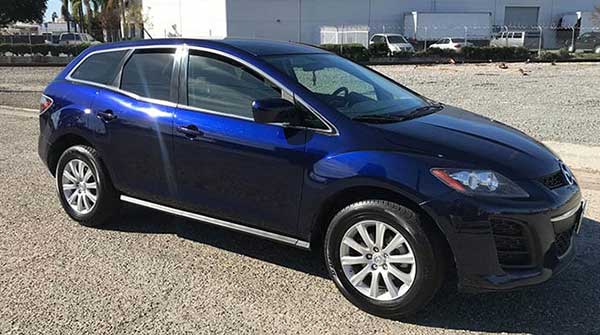
The 2011 Mazda CX-7’s level of refinement was a cut above the Ford-based Mazda Tribute, but it had less cargo space and was not available with a V6 engine.
The CX-7 was a cut above competitors, but it had less cargo space and was not available with a V6 engine or manual transmission

Available with front-wheel or all-wheel drive, the Mazda CX-7 got a bit of a facelift in 2011, continuing as a steady, if not spectacular, performer for the company. This vintage of the mid-size SUV is essentially a carryover from 2010.
While the CX-7 didn’t share its platform with any Ford products, it featured an interesting assortment of components from other Mazda products: the MPV, Mazda6 and Mazda5 all contributed to the CX-7 at one time or another.
In 2011, it was offered with either a normally-aspirated 2.5-litre four-cylinder engine or a turbocharged 2.3-litre four-cylinder. Two transmissions were available: five-speed and six-speed automatic with manual shift mode. And there were three basic trim levels: GX, GS and GT. It didn’t benefit from Mazda’s SkyActiv fuel-saving technology.
The CX-7’s level of refinement was a cut above the Ford-based Mazda Tribute, but it had less cargo space and was not available with a V6 engine or manual transmission. The turbo models were also considerably thirstier than their normally-aspirated stablemates – 12.2 litres/100 km in town versus 10.4.
The base GX had a high standard equipment level, with things like 17-inch alloy wheels, air conditioning, tire pressure monitoring system, heated mirrors, rear privacy glass, rain-sensing wipers, intermittent rear wiper, automatic headlights, cruise control, tilt and telescopic steering wheel with audio controls, trip computer with fuel consumption gauge, keyless entry, cloth seats, 60/40 split-folding rear seat, floor mats and CD/MP3 stereo. You could also get extras like 18-inch wheels and tires, climate control system, leather interior, heated front seats and a blind-spot monitoring system.
The CX-7 isn’t the roomiest SUV out there. Fold all the seats down and you have 1,658 litres of storage room, which was more than the Mitsubishi RVR, for example, but less than the Honda CR-V, Toyota RAV4 or Chevrolet Equinox. Five adults will fit, but it’s snug, and the back floor is not completely flat with the seats folded down.
There were no safety recalls on file for this year of the CX-7, but the U.S. National Highway Traffic Safety Administration (NHTSA) had a dozen technical service bulletins. These included the ubiquitous headlight lens fogging problem, a wiring issue with the airbag system resulting in random illumination of the warning light, a “clunk/bang” noise when the car is moved after sitting for a lengthy period, and a “rattling” noise coming from the engine due to a possibly loose timing chain.
The NHTSA registered seven complaints from owners. A sampling:
- “four headlamps and a battery within two years of owning the vehicle is just not right;”
- “air conditioner made loud banging noises and does not get cold;”
- “the windshield makes a cracking noise as the vehicle warms up.”
Aside from a problematic climate control system, the 2011 CX-7 got good marks right across the board from Consumer Reports, earning a “better than average” grade. Some comments from owners:
- “cheap touches throughout the cabin, especially the headliner;”
- “perfect for a family of four;”
- “definitely not a Subaru.”
From a base price of about $26,500 new in 2011, the CX-7 has stood the test of time. Depending upon the model and equipment level, you’re looking at around the $10,000 neighbourhood. The non-turbo GX is cheaper than the turbo models and the top-end GT has held its value best of all.
This was also the penultimate year for the CX-7. After 2012, it was replaced in Mazda’s lineup by the CX-5.
2011 Mazda CX-7
Original base price: $26,495
Engine: 2.5-litre four-cylinder and turbocharged 2.3-litre four-cylinder
Horsepower/torque: 161/161 and 244/258
Transmission: Five- and six-speed automatic with optional manual shift mode
Fuel economy (litres/100 km): 10.4 city, 7.2 highway (non-turbo model), with regular gas
Some alternatives: Honda CR-V, Toyota RAV4, Chevrolet Equinox, Hyundai Santa Fe, Kia Sorento, Mitsubishi RVR, Ford Escape, Mazda Tribute, Nissan Rogue, Suzuki Grand Vitara, Dodge Journey, Acura RDX, Subaru Forester
Ted Laturnus has been an automotive journalist since 1976. He was named Canadian Automobile Journalist of the Year twice and is past president of the Automobile Journalists Association of Canada (AJAC).
For interview requests, click here.
The opinions expressed by our columnists and contributors are theirs alone and do not inherently or expressly reflect the views of our publication.
© Troy Media
Troy Media is an editorial content provider to media outlets and its own hosted community news outlets across Canada.

